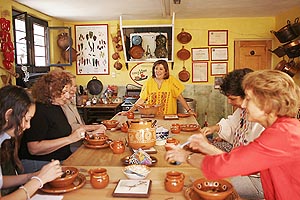 |
Mexican
Cooking with Maria
by Rachel Laudan
San Miguel is a wonderful place to live but it isn't exactly one of
the renowned centers for traditional Mexican food. As I spend my time
writing about food and its history, I've always felt a little guilty
that I wasn't heading off for Puebla, Oaxaca, Michoacán and
Veracruz, famous for their culinary traditions, instead of enjoying
the good life in Guanajuato. That's not to say that you can't eat
really well here. I've enjoyed wonderful meals in both homes and restaurants.
But when visitors turn up expecting me to put them on the inside track
to the best of Mexican food, I have found myself shuffling my feet
and apologizing for not being in one of the shrines of Mexican cooking.
Well, now I've stopped being defensive. Instead I round up my visitors
and promise them that right here in San Miguel we have someone who
is a true expert on Oaxacan and Michoacán cooking and much
else besides. That someone is María Ricaud Solórzano.
María, a charming woman in her 40s, had the luck to be born
into a family that boasted generations of passionate and reflective
cooks. From her earliest years, she watched her mother, her aunts
and her grandparents as they worked in the kitchen. Her mother’s
family had recently moved to Mexico City from Michoacán. |
 |
 |
For 40 years, her maternal aunt Lupe managed the Jockey Club, one
of Mexico’s most prestigious private clubs. To satisfy its demanding
clientele she had María’s mother prepare the traditional
sweets – flans and cocadas and ensoletados – that Mexican
gourmets loved. Her father’s side of the family supplied the
Oaxacan input. Her paternal grandfather, an expert amateur baker,
made the delicacies for María’s first communion. Her
grandmother ran the corporate dining room for the Mexican branch of
Kodak, making sure the executives enjoyed Mexican food as fine as
they would have had at home. |
On a recent visit, any worries that her family’s experiences
with high-end catering might make María’s cooking a bit
rarified quickly evaporated as she explained the basics of making
the most traditional of Mexican dishes, tamales. It’s the taste
and texture of the tamal itself that matter, she explained when one
of us asked why the filling was less ample than in American tamales.
The filling is just a little extra gift, a surprise, to delight the
taste buds. As we relished her range of savory and sweet tamales,
including the delicious Oaxacan tamales wrapped in banana leaves,
we began to see why and to feel that we were learning not just the
techniques but also the aesthetics of Mexican cuisine.
Lovely as María’s tamales are, they’re too time-consuming
for me to make regularly. So I was delighted with her class on sauces.
She took us through the difference between salsas, moles, adobos,
pipians and all the other preparations. Then we made half a dozen
salsas, learning how to ring variations on each. Better yet, María
showed how, with a pair of salsas in the fridge, we could turn out
dozens of different dishes ranging from homey chilequiles to fragrant
soups, stews and elegant marinated roasts.
So, no longer am I going to worry that I am short-changing my guests
if I don’t urge them to plunge into the summer heat of Oaxaca
or the urban congestion of Puebla. Instead we will wend our way through
the streets of Colonia San Antonio in San Miguel to find out a bit
more about Mexican cooking in María’s kitchen.
Rachel Laudan, author of Julia Child prize-winning Food of Paradise:
Exploring Hawaii’s Culinary Heritage (1996) writes on food for
publications such as Gastronomica, Scientific American and the Los
Angeles Times.
|
 |